How do Iowans work to provide for themselves, their families and their communities?
Every family needs a source of income to pay for essentials like food, clothing and housing. Most Iowans earn a salary or the profits from their business or services. Certain groups receive support from retirement funds or government programs in health care or public assistance. But it is safe to say that most Iowans work for a living. Recent government figures shows that some 1.6 million Iowans are currently in the work force.
Early 20th Century Jobs
The jobs Iowans have done have changed over the past 120 years. In 1900, a majority of Iowans lived on farms. Without the large-scale machinery we have today, farmers rarely managed over a half acre (320 acres) because it took too much time to plant, cultivate and harvest the crops. Most farm families, however, raised livestock for sale, milked cows for butter and their home use, and kept flocks of chickens for the eggs and meat. They also planted large gardens and canned vegetables for the winter. The husband and wife worked together on the farm as a team, each responsible for his or her own parts of the operation. Children learned farming and housekeeping from their parents and became an important part of the successful operation.
Cities and towns offered many manufacturing jobs in agricultural equipment and meat packing. There were many small coal mines that attracted immigrants from countries Italy, Croatia, Sweden and Wales. However, as railroads began shifting away from coal to diesel fuel and coal sources became depleted, the coal industry had all but disappeared by the 1940s.
Shift from Agriculture to Other Sectors
World War II brought a surge of industrial jobs to the state as the government needed supplies to fight the war. Farm machinery plants shifted to war equipment and smaller factories turned out ammunition. Meat packing continued to be an important source of factory work.
As farm machinery became bigger and more powerful, farmers could manage larger and larger operations. This, of course, meant that there were fewer farms and fewer farm families. Iowa cities began growing with the rise of manufacturing and financial occupations like insurance. Des Moines is one of the two largest centers for insurance in the nation. Education and health care are two more important sectors in the Iowa employment picture. Colleges and universities saw rapid growth after World War II with the GI Bill, making it possible for many more young people to afford college and Baby Boomers swelling the ranks of college-age youth.
The late 20th century saw a revolution in communication with the introduction of computers and cell phones. The first computer was invented by John Atanasoff at Iowa State University. Robert Noyes, a graduate of Grinnell College, did pioneering work in the development of microchips which did much to make the computer revolution possible. While there was a decline in some areas of manufacturing toward the end of the century and a continued decline in farm employment, computers sparked the growth of new industries. Wind and solar energy also began needing workers to build, install and maintain clean energy equipment. Government saw an expansion at all levels with the growth of regulation and support programs.
To provide Iowan with the training they need to fill positions in today's job market, the state created a system of community colleges geared to job training programs. The state also began investing in work placement programs to match workers with job openings. Today, Iowa has one of the lowest unemployment rates in the nation. Unfortunately, many jobs in the service and health care areas pay wages so low that workers struggle to meet their expenses even if they work full time.
Education is a critical factor in the employment picture. Many high schools offer job-training classes and coordinate curriculum with nearby universities and community colleges. The state itself is critically invested in producing and supporting a skilled labor force that allows Iowans to work and support families here.
About the Source Set
The first two supporting questions list the top five occupations self-reported by Iowans (by gender) in 1900 and 1950. This information was compiled by Willis Goudy, a professor of sociology at Iowa State University, who published this chart in his 2008 book, Iowa’s Numbers: 150 Years of Decennial Census Data With a Glance to the Future. The third supporting question looks at how occupations changed over time in regard to sex and cultural norms.
Supporting Questions
How did Iowans make a living to support their families and communities in 1900 according to census records?
- Men:
1. Farmer Plowing with a Two-Horse Team, ca. 1900 (Image)
2. Man Feeding Pigs in the Barnyard, ca. 1895 (Image)
3. Farm Laborers Gathering Potatoes in Fort Bend County, Texas, 1909 (Image)
4. Men Outside the Des Moines Brick Company, ca. 1900 (Image)
5. E.J. Crane, Watchmaker and Jewelry Store, in Richmond, Virginia, 1899 (Image)
- Women:
1. Servants in Bulloch Hall's Dining Room in Roswell, Georgia, March 27, 1907 (Image)
2. Teacher and Students at Whittier Primary School in Hampton, Virginia, ca. 1899 (Image)
3. Dressmaker Angelina Guinzali in Boston, Massachusetts, January 25, 1917 (Image)
4. Mountain Milk Maids, ca. 1900 (Image)
5. Cook in White House Kitchen, ca. 1890 (Image)
How did Iowans make a living to support their families and communities in 1950 according to census records?
- Men:
1. Elias Eliason Cultivating Corn in Kanawa, Iowa, 1949 (Image)
2. Farm Laborers in Fort Dodge, Iowa, August 1957 (Image)
3. Two Men Working on a Maytag Washing Machine in Newton, Iowa, October 1949 (Image)
4. Construction Workers at Mercy Hospital in Des Moines, Iowa, July 1957 (Image)
5. Salesman Selling a Hat to a Customer in Chicago, Illinois, April 1952 (Image)
- Women:
1. Saleswoman Arranging Figurines at J.C. Penney in Des Moines, Iowa, February 1949 (Image)
2. Teacher and Students at Wheatly Elementary School, September 16, 1957 (Image)
3. Secretary Betty Goodell in Clear Lake, Iowa, 1950 (Image)
4. Women Working Bore Presses at Wood Brothers Plant in Des Moines, Iowa, 1955 (Image)
5. Workers Harvesting Cucumbers in Muscatine Iowa, July 1959 (Image)
How do people make a living to support their family and community in the 2000s that is different than previous eras?
- Flight Attendant for Southwest Airlines, June 25, 2012 (Image)
- Second-Grade Teacher at Canaan Elementary in Patchogue, New York, June 18, 2015 (Images)
- Iowa Astronaut Peggy Whitson, 2017 (Image)
- Registered Nurses, 2018 (Images)
- Des Moines Firefighters Stand by a Fire Engine, 2019 (Image)
- News Anchor Rheya Spigner in Des Moines, Iowa, 2019 (Images)
- Park Ranger with Volunteers at Stone Park in Iowa, 2019 (Images)
- Receptionist Helping a Guest at the State Historical Museum, 2019 (Image)
- State Historical Society of Iowa Librarian Helping a Patron, 2019 (Images)
- U.S. Senator Joni Ernst from Iowa, 2019 (Images)
| People at Work Teaching Guide |
| Printable Image and Document Guide |
Farmer Plowing with a Two-Horse Team, ca. 1900
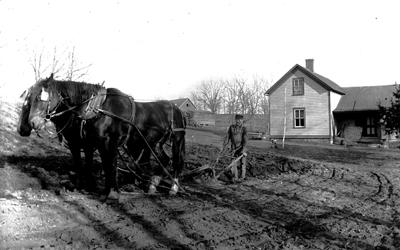
Description
#1 Occupation: Farmer
In 1900, Iowa was all about farming. From about the 1850s to 1880s, people had recently moved to the state and either bought land at a very good price ($1.25 an acre) or signed up for 160 acres for free through the Homestead Act. By 1900, Iowa…
Man Feeding Pigs in the Barnyard, ca. 1895
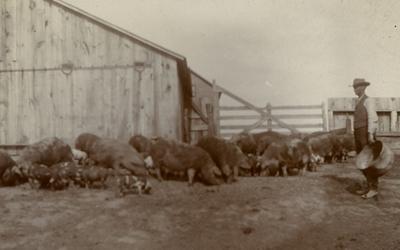
Description
#2 Occupation: Farm Laborer, Member of Farm Family
Farming was a very big job around 1900, requiring lots of hours and a great deal of hard work. Farmers typically raised crops such as corn, soybeans and oats and livestock such as cows, horses, hogs and chickens.…
Farm Laborers Gathering Potatoes in Fort Bend County, Texas, 1909
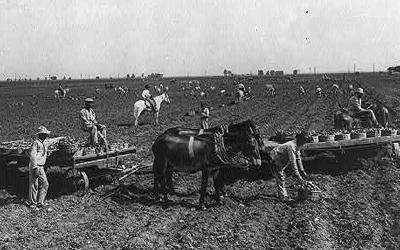
Description
#3 Occupation: Farm Laborer
When farmers did not have enough help from family members, they would hire additional help. Farm laborers did the same tasks as farmers, but they did not own the farm. In this photograph, many workers are seen harvesting potatoes in a…
Men Outside the Des Moines Brick Company, ca. 1900
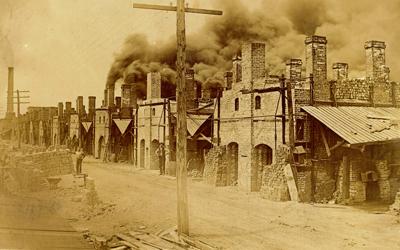
Description
#4 Occupation: General Laborer
General laborers did many things such as make bricks, operate a saw mill, build roads, paint buildings or several other jobs. Many of these workers were called "day laborers" and hired to complete a specific job and then moved on to…
E.J. Crane, Watchmaker and Jewelry Store, in Richmond, Virginia, 1899
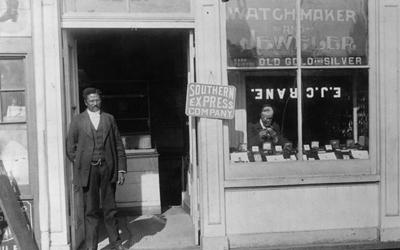
Description
#5 Occupation: Merchant (Store Owner)
Stores in 1900 were smaller than most of the stores we see today. In small towns, stores carried many kinds of products: clothes, food, wagon/machine/auto parts, dishes, tools, hats and many other items. In cities, stores…
Servants in Bulloch Hall's Dining Room in Roswell, Georgia, March 27, 1907
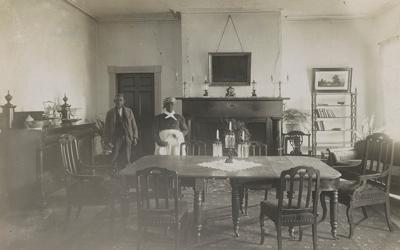
Description
#1 Occupation: Servant
In 1900, servants took care of the household, and sometimes, the people who lived there. Servants might dust, like the woman in this image, mop floors, tend fires, run errands and do the shopping, wash laundry and help family members with…
Teacher and Students at Whittier Primary School in Hampton, Virginia, ca. 1899
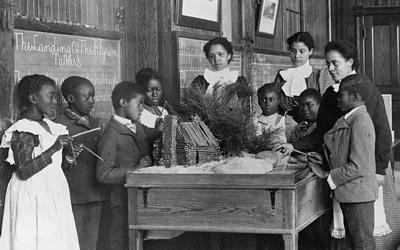
Description
#2 Occupation: Teacher
By 1900, more and more kids in Iowa were going to school. In rural places, a one room school had many grades learning together with one teacher. In urban places, such as in this photo, a teacher had a class of students who were all in…
Dressmaker Angelina Guinzali in Boston, Massachusetts, January 25, 1917
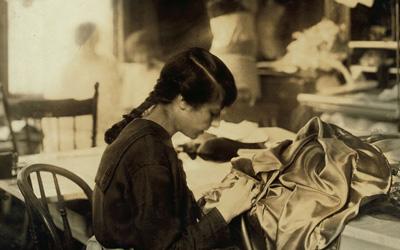
Description
#3 Occupation: Dressmaker
As fashions became more elaborate and railroad systems made them more available throughout the United States, dressmakers transitioned from sewing by hand to using a sewing machine. Angelina Guinzali, seen in this photo, is about 15 years…
Mountain Milk Maids, ca. 1900
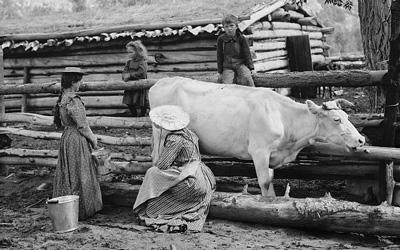
Description
#4 Occupation: Farmer
Part of women's work on a frontier farm was taking care of livestock that provided food for her family. Milking was done twice a day, and then the milk had to be separated from the cream. Some farms used an icebox to keep milk and cream cold,…
Cook in White House Kitchen, ca. 1890

Description
#5 Occupation: Housekeeper
In 1900, the work of housekeepers and servants probably looked very similar. In larger homes, more hired help meant that they could specialize and only do certain tasks. A housekeeper would have been in charge of taking care of the house…
Elias Eliason Cultivating Corn in Kanawa, Iowa, 1949
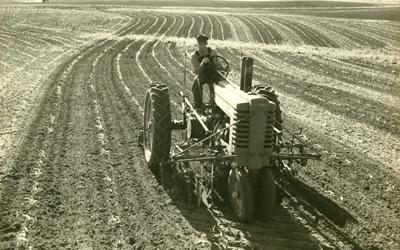
Description
#1 Occupation: Farmer (owner or tenant)
In 1950, farming was still the number one occupation for men in Iowa. Advances in technology, like the one Elias Eliason is using to cultivate his corn field near Kanawha, Iowa, allowed a farmer to farm more acres of land.…
Farm Laborers in Fort Dodge, Iowa, August 1957
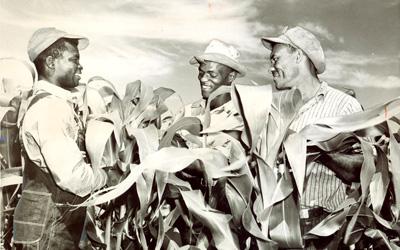
Description
#2 Occupation: Farm Laborer
These men are detasseling corn near Fort Dodge, Iowa. They are migrant workers, which means that they moved from farm to farm doing whatever job was needed at the time. They were paid an hourly wage. Farm laborers did the same jobs as…
Two Men Working on a Maytag Washing Machine in Newton, Iowa, October 1949
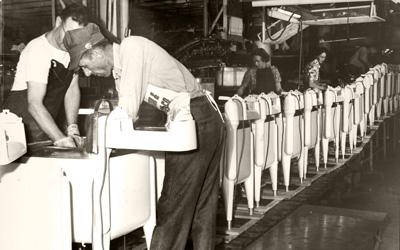
Description
#3 Occupation: Manufacturing Operative
The Maytag factory in Newton, Iowa, was a pillar of the community for decades. In this photograph, manufacturing operatives work on an assembly line for wringer washing machines. Factories throughout Iowa had good paying,…
Construction Workers at Mercy Hospital in Des Moines, Iowa, July 1957

Description
#4 Occupation: Nonmanufacturing Laborer
Mercy Hospital in Des Moines, Iowa, hired this construction company to build an addition to their building. A crane operator and dump truck driver removes excavated soil as they prepare to start the foundation for the…
Salesman Selling a Hat to a Customer in Chicago, Illinois, April 1952
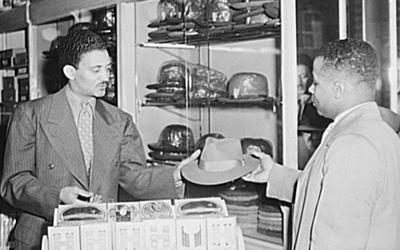
Description
#5 Occupation: Retail Trade Manager, Official or Proprietor
In other words, store owner or manager. Stores in the 1950s were more specialized than stores in the 1900s. In this photograph, William Strong is the manager of the Henry C. Taylor Store for Men in Chicago…
Saleswoman Arranging Figurines at J.C. Penney in Des Moines, Iowa, February 1949
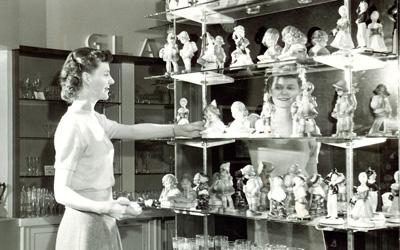
Description
#1 Occupation: Retail Trade Saleswoman or Sales Clerk
The J.C. Penney Company department store in Des Moines, Iowa, was a large store that arranged items into different departments. This sales clerk was arranging figurines in the glassware department. Sales clerks…
Teacher and Students at Wheatly Elementary School, September 16, 1957
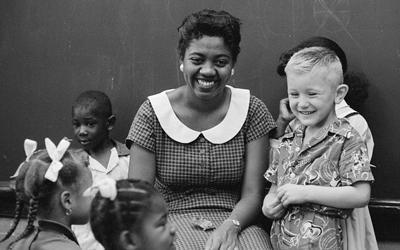
Description
#2 Occupation: Teacher
By 1950, many of the one-room schools had closed and students rode school busses to a larger school building in town. Most all elementary classrooms had only one grade level of students in a classroom. Classroom teachers taught math, reading…
Secretary Betty Goodell in Clear Lake, Iowa, 1950
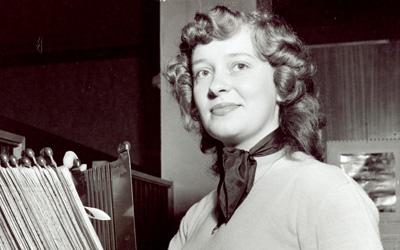
Description
#3 Occupation: Stenographer, Typist or Secretary
As businesses grew larger and more complex, some businesses added secretaries. Secretaries would likely have typing skills but were also asked to file papers, answer phone calls, write notes, sort incoming mail and…
Women Working Bore Presses at Wood Brothers Plant in Des Moines, Iowa, 1955
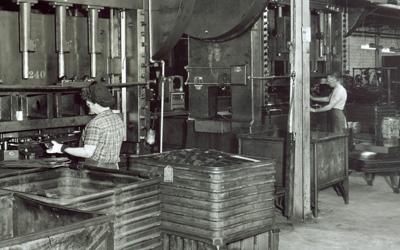
Description
#4 Occupation: Manufacturing Operative
During World War I and especially during World War II, many men in the United States left factory jobs to enter the military, and many women took on manufacturing operative jobs in factories. When the war was over, many women…
Workers Harvesting Cucumbers in Muscatine Iowa, July 1959
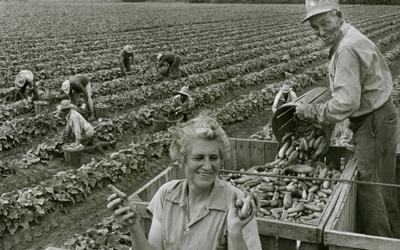
Description
#5 Occupation: Farm Laborer, Unpaid Family Worker
Many jobs on the farm, such as harvesting a large field of cucumbers for the Heinz Company near Muscatine, Iowa, required several people to do. In the 1950s, many families worked together in order to have enough…
Flight Attendant for Southwest Airlines, June 25, 2012
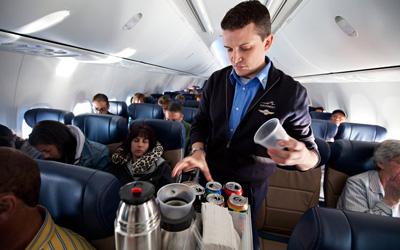
Description
This photograph shows a Southwest Airlines flight attendant serving drinks during a flight.
Second-Grade Teacher at Canaan Elementary in Patchogue, New York, June 18, 2015

Description
These photographs show Thomas Whaley working with his second-grade students as they learn English throughout the year. Whaley is shown in his classroom at Canaan Elementary in Patchogue, New York.
Iowa Astronaut Peggy Whitson, 2017
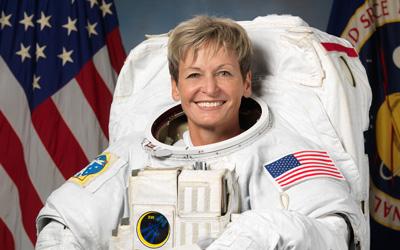
Description
Peggy A. Whitson participated in ten spacewalks. With a total of 665 days in space, Whitson holds the U.S. record, placing eighth on the all-time space endurance list. The Iowa native also completed two six-month tours of duty aboard the space station in 2002, and as the…
Registered Nurses, 2018
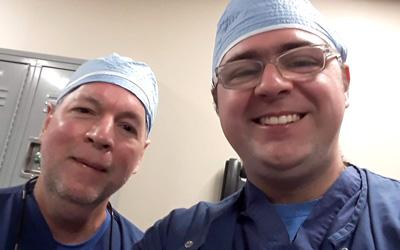
Description
These photos from the American Association for Men in Nursing (AAMN) show registered male nurses posing for a photo and performing for some patients. The demand for more male nurses is on the rise, and AAMN are campaigning for a 20 percent increase in the number of male…
Des Moines Firefighters Stand by a Fire Engine, 2019

Description
This image shows four Des Moines firefighters standing by a fire engine. Shown left to right: Engineer Kerri Przybylski, Fire Station 10; Senior Medic Nadine Sechovec, Fire Station 4; Senior Medic Laura Lyons, EMS Section; and Firefighter Danielle Edwards, Fire Station 5.
News Anchor Rheya Spigner in Des Moines, Iowa, 2019

Description
These photographs feature KCCI news anchor Rheya Spigner in Des Moines, Iowa. Spigner is the third anchor on KCCI 8 News This Morning, and she also anchors traffic in the morning and KCCI 8 News at Noon.
Park Ranger with Volunteers at Stone Park in Iowa, 2019
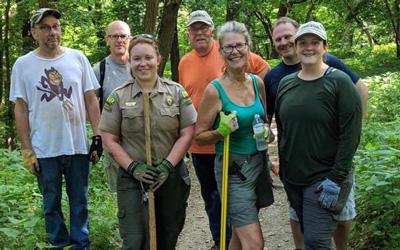
Download Resource Download Resource
Description
Park Manager Brianna Martens, front left with shovel, works with volunteers from the Friends of Stone Park in Iowa to build and reinforce water bars (erosion prevention) on the Mt. Lucia Trail in Stone State Park.
Receptionist Helping a Guest at the State Historical Museum, 2019
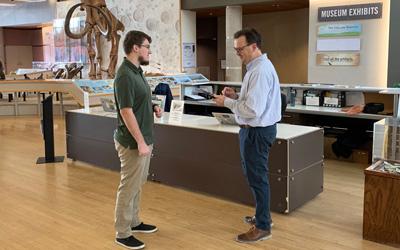
Download Resource Download Resource
Description
This photograph show the State Historical Museum of Iowa receptionist Brain Trotter. Trotter is shown helping a visitor check in at the museum.
State Historical Society of Iowa Librarian Helping a Patron, 2019

Description
Librarian Bruce Kreuger from the State Historical Society of Iowa is shown working with a patron to help her with a research project.
U.S. Senator Joni Ernst from Iowa, 2019
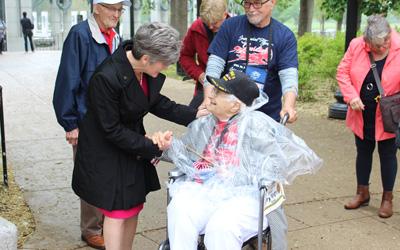
Description
These photographs showcase U.S. Senator Joni Ernst of Iowa. One shows Ernst visiting with employees at Performance Pipe in Davis County on August 13, 2019. This was part of Ernst's 99 county tour in 2019. She was the first female U.S. senator elected from Iowa.
"Ten Most Frequently Listed Occupations by Sex, Iowa, 1900-2000," 2008

Description
Willis Goudy, a professor of sociology at Iowa State University, published this chart in his 2008 book, Iowa's Numbers: 150 Years of Decennial Census Data With a Glance to the Future. This chart lists the number of Iowans who self-reported their occupation as one of…
Additional Resources:
- Photo Collection: Top Ten Occupations for Men in Iowa (1900 to 2000)
This document features images of the top 10 occupations self-reported by Iowans who identified as male for 1900, 1950 and 2000. - Photo Collection: Top Ten Occupations for Women in Iowa (1900-2000)
This document features images of the top 10 occupations self-reported by Iowans who identified as female for 1900, 1950 and 2000. - Distribution of Iowa's Urban Population Map, 1930
This map was created by the State Planning Board of Iowa's Committee on Population Social Trends in 1930. It shows which of Iowa’s 99 counties have more urban areas and which counties have more rural areas. In 1930, the United States Census Bureau defined “urban” as having a population of 2,500 or more. This map is intended to be used with the "State Map of County and City Maps, 2018" in order to show growth over time. - Evolution of the Maytag Wringer Washer
This webpage features a timeline of photos showing the evolution of the Maytag Wringer Washer. This additional resource connects to the laundress in the 1900s and the manufacturing operative in the 1950s. - "In the Millinery Shop" from The Goldfinch, November 1986
This article appeared in the November 1986 edition of The Goldfinch: Iowa History for Young People. It tells about the occupation of millinery and features quotes from Elizabeth Wright Heller who sold hats in 1880 at Mrs. Ann Swezey’s millinery shop in Marengo, Iowa along with other milliners and customers. - "Iowa: a State of Work," from The Goldfinch, 1996
Amy Roth wrote this article for the Summer 1996 edition of The Goldfinch: Iowa History for Young People. This article explains different eras of work in Iowa over time, including in agriculture and manufacturing. - Multiple Graphs, Charts and Graphics Featuring Iowa's Population and Occupation
Willis Goudy, a professor of sociology at Iowa State University, published his 2008 book, "Iowa’s Numbers: 150 Years of Decennial Census Data With a Glance to the Future." Multiple charts and graphs from the book and other sources are looking at Iowa's population and popular occupation in rural and urban areas in this additional resource. - "My Next Move" Website
The "My Next Move" website is a searchable collection of careers hosted by the U.S. Department of Labor, Employment & Training Administration. - "Threshing on the Farm" from Living History Farms
This Living History Farms webpage tells the story of the Wood Brothers Factory and contains video clips on how a Wood Brothers Steam Engine and threshing machine worked. This additional resource connects to the manufacturing operative and farm laborer in the 1950s. - "Who Worked Where?" from The Goldfinch, 1996
This excerpt from The Goldfinch: Iowa History for Young People includes a mapping activity to meet standard SS.1.16. and connect with this unit of study about work.
Iowa Core Social Studies Standards (1st Grade)
Listed below are the Iowa Core Social Studies content anchor standards that are best reflected in this source set. The content standards applied to this set are elementary-age level and encompass the key disciplines that make up social studies for 6th through 12th-grade students.
| No. | Standard Description |
| SS.1.11. | Compare the goods and services that people in the local community produce with those that are produced in other communities. |
| SS.1.12. | Explain why people in one country trade goods and services with people in other countries. |
| SS.1.13. | Explain why people have different jobs in the community. |
| SS.1.16. | Using maps, globes, and other simple geographic models, compare and contrast routes for people or goods that consider environmental characteristics. |
| SS.1.19. | Compare how people in different types of communities use goods from local and distant places to meet their daily needs. |